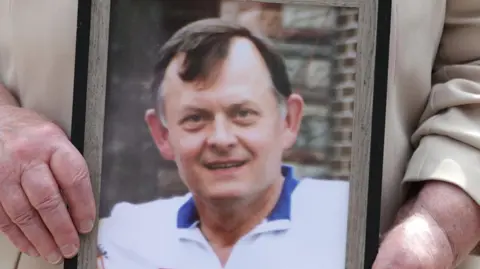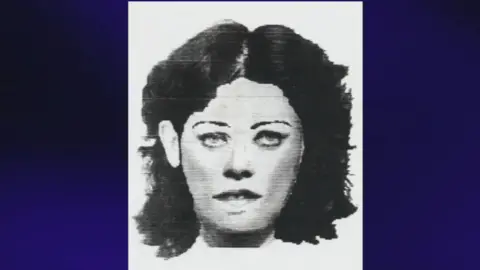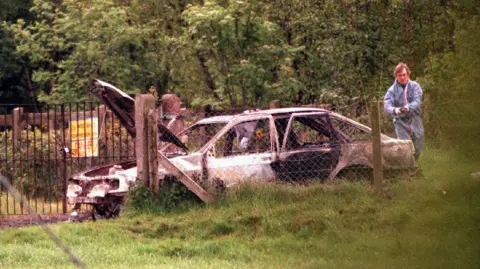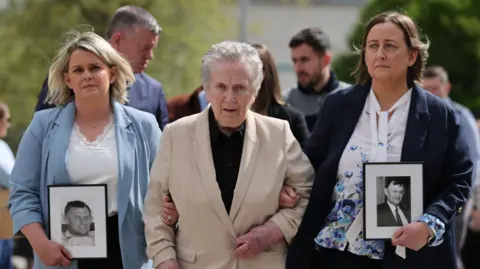Sean Brown murder witness tells of suspect sighting for first time
 PA Media
PA MediaAn eyewitness to the murder of man nearly 30 years ago has said he was "baffled" that a female suspect he picked out of an identity parade shortly after the murder was released without charge.
Sean Brown, 61, was abducted by the Loyalist Volunteer Force at a GAA club in Bellaghy, County Londonderry, and shot dead near Randalstown, County Antrim, in 1997.
The eyewitness, who is speaking publicly for the first time, saw the woman with two men in a car at the club the night before the murder in what is suspected to have been a scouting mission.
The Police Service of Northern Ireland (PSNI) said the Brown family had too many unanswered questions and those questions were "valid".
Crimewatch Appeal
In 2024 a court heard more than 25 people, including state agents, had been linked by intelligence to Mr Brown's murder.
The information the eyewitness provided about the woman and the car, a white Vauxhall Nova, was central to a fresh PSNI inquiry and BBC Crimewatch appeal in 2005.
The BBC is calling the witness John to disguise his identity because of his fear of reprisals.
John told Spotlight what happened the night before the murder of Mr Brown, who was chairman of the Bellaghy club.
"I was the last one going out. Sean was still there to lock up," he said.
"I just thought it was just someone turning at the front of the club.
"The lady that was driving the car stared me straight in the face.
"There was two men and they were hiding their faces."

Original investigation 'inadequate'
John told the Spotlight programme, Murder Without Answers, that he took his information to the Royal Ulster Constabulary (RUC) shortly after Mr Brown's murder.
He helped compile a photofit and was then brought to Belfast to an identity parade.
"I picked her out right away. I seen the same face right away," he said.
"The woman constable was standing beside me, and she says, yes we have her."
John said that after the identity parade he was shocked when the woman he picked out and other suspects were released.
"I went home and kept listening to the radio, watching TV and a couple of days later these people were let out without charge," he said.
"It left me baffled. I'm still thinking – why?"
A Police Ombudsman examination of the case in 2004 found the original RUC investigation was "incomplete and inadequate".
It has since emerged some intelligence information was not provided to the ombudsman at the time.
 Pacemaker
PacemakerWhat have the police said?
No-one has ever been charged over Mr Brown's murder and it is now known that intelligence was withheld from detectives in both the original RUC probe and the re-investigation by the PSNI.
In a statement to Spotlight, the PSNI said Mr Brown was a "pillar of the community" and his family had a right to know what happened.
It added that it had previously apologised to the Brown family for failings in the RUC investigation and was sorry for what was discovered during new inquiries.
Mr Brown's daughter Clare Loughran told Spotlight that receiving information about state agents last year confirmed her family's suspicions.
"I felt physically sick," she said.
"The wave of emotion was incredible. It was very, very difficult to hear."
 PA Media
PA MediaSean Brown's family campaign for public inquiry
Her sister Siobhán Brown said it prompted further questions:
"You'd wonder why first of all, how long has this been planned for. What or who was involved?" she said.
"Who gave the order from on high to say Sean Brown has to be taken out?"
The Brown family have long campaigned for a public inquiry into the murder.
The government has appealed a court ruling that found it should hold a public inquiry, arguing it was not an issue which the courts should decide.
It also believes the implications of the court ruling would go beyond the Brown case.
Northern Ireland Secretary Hilary Benn said he expressed his deepest sympathy to the Brown family for the many years they have waited for answers.
He said he intended to ensure the Independent Commission for Reconciliation and Information Recovery (ICRIR), established under the Legacy Act, would be able to carry out an investigation comparable to a public inquiry.
However, some victims' families say the ICRIR does not have the powers to investigate such cases.
The ICRIR told Spotlight that proposed legislative reforms could result in it being able to have human rights compliant hearings led by an independent judge.
